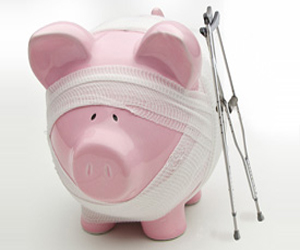Send this article to a friend:
December
09
2022
Send this article to a friend: December |
Ben Bernanke Wrecked the U.S. Economy and Won a Nobel Prize
I already knew that Ben Bernanke was a student of the Great Depression. I wasn’t aware of his exact perspective, though, or his claim that bank failures were the cause of that brutal decade. The Nobel Prize committee explains:
Now, at least, we can gain some understanding of his actions during the Great Financial Crisis. That understanding comes at a price, though – the cost is 40-year record-high inflation, and both you and I, along with every other American, are paying for it. Here’s a real quick lesson in recent economic history, courtesy of Christopher Leonard’s masterful work, The Lords of Easy Money.
And:
Keep in mind, this is what Bernanke’s Federal Reserve did. (We aren’t even talking about Fed Chair Jerome Powell’s term.) Back to the Nobel Prize committee:
Here’s the important part:
The main thing most people don’t realize about the Federal Reserve is that they do a whole lot more than just managing the money supply and interest rates. Here’s how Christopher Leonard put it:
Inflationary, easy-money policies like quantitative easing and low interest rates disproportionately benefit the wealthy – at the expense of everyone. Does that sound like an exaggeration? Let’s look at the data… Here are the per-person outcomes of the Federal Reserve’s latest round of inflationary pandemic policies:
You don’t have to look very hard to find evidence of the unequal impact of inflation on American citizens. The top 1% wealthiest Americans benefited 2,366x more, per person, than the lowest half of our nation’s earners. (If you’ve ever wondered why Wall Street is always griping about interest rates and begging the Fed to “pivot,” well, there’s your answer.) That’s astonishing. And current Fed Chair Jerome Powell knows this. Keep in mind, he was a member of the Federal Reserve Board of Governors from 2012-2018, during which time the Federal Reserve increased the money supply rose 40%. Back in March 2021, Powell rationalized and defended the Fed’s massive bailout of the stock market in an op-ed for the Wall Street Journal. Wolf Richter parodied Powell’s statement:
Why do the already-wealthy, the top 1% wealthiest Americans, benefit so disproportionately from easy-money policies? It’s quite simple: they own most financial assets. When Powell’s op-ed appeared in the Wall Street Journal, wealth distribution in the U.S. looked like this:
Inflationary policies are great for financial assets. Meanwhile, for everyone, life gets more expensive. Housing, food and energy costs surge. Inflation reduces the purchasing power of labor. If you’re accustomed to wagyu filet mignon for dinner, and the price of steak gets too high, you can always eat hamburger instead. If you eat hamburgers for dinner, but they’re expensive, you can always buy beans or lentils. If you eat beans and lentils for dinner and those get too expensive, you go hungry. The Federal Reserve is the opposite of the British folk hero, Robin of Loxley – who famously robbed from the rich to give money to the poor. And that’s not all – the Federal Reserve’s policies have actively eroded the prudence and caution we’d expect from our financial institutions… Entitlement culture and moral hazard Bernanke’s decision to bail out global banks and insurance companies and, well, just about every corporation who asked, a truly mind-boggling 991 different corporations, created what economists call “moral hazard.” If you’re a parent, you’re familiar with this concept. If you let your children make dumb choices, and then fix the consequences, you teach them that dumb choices are safe. In my mind, moral hazard is linked to entitlement culture. The attitude that “the world owes me.” In the business world, moral hazard means corporations are actually incentivized to make high-risk decisions – because if those gambles pay off, they win big. And if those gambles fail spectacularly, someone else will clean up the mess. Who’s that someone else? Why, the Federal Reserve! And who pays the bill? The American taxpayer pays directly – and we all pay indirectly, though the inflation tax. Ben Bernanke, and his disciple Jerome Powell, have slashed the purchasing power of every dollar in existence by 33% since Bernanke’s tenure as chairman of the Federal Reserve began in 2006:
We rely on the dollar as a “unit of account,” meaning prices for goods and services are set in dollars. We measure wealth in dollars today, just as the Maasai of Kenya measure their net worth in cattle. The problem with dollars is their value changes over time. It’s subject to manipulation by central bankers, who may decide at any time to (once again) print a century’s worth of money in a single year. But creating more dollars doesn’t create more wealth (unless you’re already rich). Instead, the inflationary effects of money-printing actually create more poverty. I believe the U.S. dollar has run its course. It’s impossible to know the true value of goods and services because we just don’t know how rapidly the dollar will depreciate in the future. Compare to gold and other precious metals. They’re obviously money, because people will choose to be paid in the original “cold, hard cash” whenever possible. They’re immune to inflation because you can’t just print more gold or silver. Until we can stop the Federal Reserve from destroying the value of the U.S. dollar, I think it’s smart to diversify our long-term savings with real-money assets like physical gold and silver. That’s one of the best ways to shelter our financial futures from the Fed-sponsored cycle of inflation and wealth redistribution.
|
Send this article to a friend:
 |
 |
 |